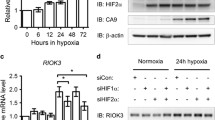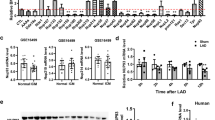Abstract
Cytoskeletal protein β-actin is abundant both in the cytoplasm and the nucleus, its mRNA is commonly utilized an internal control for gene expression analysis. Recent reports demostrated that hypoxia influences the levels of β-actin in a variety of cells. The mechanism underlying this change are not yet elucidated. In this work, we show that the changes in the levels of hypoxia-induced Nuclear respiratory factor-1 (NRF-1) lead to the change in expression of β-actin. We compared the protein levels of NRF-1 and β-actin in gastric cancer and adjacent tissues and found their significantly upregulation in cancer (33% patitents). When gastric cancer cells and normal gastric cells were treated with 1% O2 for 48 h, the trends in expression levels of NRF-1 and β-actin were similar. When NRF-1 expression was modified by its overexpressing or silencing, the levels of β-actin changed accordingly. In β-actin gene (ACTB), three binding sites for NRF-1 were found. These sites are conserved in human, mouse and rat genomes. In ChIP experiments, we showed that NRF-1 directly binds to human ACTB and mouse Actb coding regions. Its seems that the transcription of β-actin encoding gene is NRF-1 dependent.



Similar content being viewed by others
REFERENCES
Sturzenbaum S.R., Kille P. 2001. Control genes in quantitative molecular biological techniques: The variability of invariance. Comp. Biochem. Phys. B. 130, 281‒289
Farrants A.K.O. 2008. Chromatin remodelling and actin organisation. FEBS Lett. 582, 2041‒2050.
Rohn G., Koch A., Krischek B., Stavrinou P., Goldbrunner R., Timmer M. 2018. ACTB and SDHA are suitable endogenous reference genes for gene expression studies in human astrocytomas using quantitative RT-PCR. Technol. Cancer Res. Treat. 17, 1533033818802318.
Yang Y., Ma L., Ge R., Fan W., Zhu L., Zhao T., Wu Y., Fan M. 2008. Effects of hypoxia on mRNA expression of housekeeping genes in rat brain tissue and primary cultured neural cells. Front. Med. China. 2, 239‒243. https://doi.org/10.1007/s11684-008-0045-7
Zhong H., Simons J.W. 1999. Direct comparison of GAPDH, beta-actin, cyclophilin, and 28S rRNA as internal standards for quantifying RNA levels under hypoxia. Biochem. Biophys. Res. Commun. 259, 523‒526.
Bruge F., Venditti E., Tiano L., Littarru G.P., Damiani E. 2011. Reference gene validation for qPCR on normoxia- and hypoxia-cultured human dermal fibroblasts exposed to UVA: Is beta-actin a reliable normalizer for photoaging studies? J. Biotechnol. 156, 153‒162.
Glass J.J., Phillips P.A., Gunning P.W., Stehn J.R. 2015. Hypoxia alters the recruitment of tropomyosins into the actin stress fibres of neuroblastoma cells. BMC Cancer. 15, 712.
Haghparast S.M.A., Kihara T., Shimizu Y., Yuba S., Miyake J. 2013. Actin-based biomechanical features of suspended normal and cancer cells. J. Biosci. Bioeng. 116, 380‒385.
Al Absi A., Wurzer H., Guerin C., Hoffmann C., Moreau F., Mao X.Q., Brown-Clay J., Petrolli R., Casellas C.P., Dieterle M., Thiery J.P., Chouaib S., Berchem G., Janji B., Thomas C. 2018. Actin cytoskeleton remodeling drives breast cancer cell escape from natural killer-mediated cytotoxicity. Cancer Res. 78, 5631‒5643.
Tseng R.C., Chang J.W., Mao J.S., Tsai C.D., Wu P.C., Lin C.J., Lu Y.L., Liao S.Y., Cheng H.C., Hsu H.S., Wang Y.C. 2015. Growth-arrest-specific 7C protein inhibits tumor metastasis via the N-WASP/FAK/F-actin and hnRNP U/beta-TrCP/beta-catenin pathways in lung cancer. Oncotarget. 6, 44207‒44221.
Liu Y., Wang Z.Y., Huang D., Wu C., Li H.H., Zhang X., Meng B., Li Z.J., Zhu T.H., Yang S., Sun W. 2017. LMO2 promotes tumor cell invasion and metastasis in basal-type breast cancer by altering actin cytoskeleton remodeling. Oncotarget. 8, 9513‒9524.
Dai Q.S., Shah A.A., Garde R.V., Yonish B.A., Zhang L., Medvitz N.A., Miller S.E., Hansen E.L., Dunn C.N., Price T.M. 2013. A truncated progesteronereceptor (PR-M) localizes to the mitochondrion and controls cellular respiration. Mol. Endocrinol. 27, 741‒753.
Hoppeler H., Vogt M., Weibel E.R., Fluck M. 2003. Response of skeletal muscle mitochondria to hypoxia. Exp. Physiol. 88, 109‒119.
Yuan X.M., Chen C.Z., Wang L., He X. 2017. Inhibition of microRNA-182 reduces hypoxia/re-oxygenation-induced HL-1 cardiomyocyte apoptosis by targeting the nuclear respiratory factor-1/mitochondrial transcription factor A (NRF-1/mtTFA) pathway. Int. J. Clin. Exp. Pathol. 10, 5162‒5170.
Evans M.J., Scarpulla R.C. 1989. Interaction of nuclear factors with multiple sites in the somatic cytochrome c promoter. Characterization of upstream NRF-1, ATF, and intron Sp1 recognition sequences. J. Biol. Chem. 264, 14361‒14368.
Virbasius C.A., Virbasius J.V., Scarpulla R.C. 1993. NRF-1, an activator involved in nuclear–mitochondrial interactions, utilizes a new DNA-binding domain conserved in a family of developmental regulators. Genes Dev. 7, 2431‒2445.
Satoh J., Kawana N., Yamamoto Y. 2013. Pathway analysis of ChIP-Seq-based NRF1 target genes suggests a logical hypothesis of their involvement in the pathogenesis of neurodegenerative diseases. Gene Regul. Syst. Bio. 7, 139‒152.
Jayanta K.D., Quentin F., Robert P., Robert M.J., Deodutta R. 2018. Nuclear respiratory factor 1 acting as an oncoprotein drives estrogen-induced breast carcinogenesis. Cells. 7, 234.
Wang D., Zhang J., Lu Y.P., Luo Q.Q., Zhu L. 2016. Nuclear respiratory factor-1 (NRF-1) regulated hypoxia-inducible factor-1 (HIF-1) under hypoxia in HEK293T. IUBMB Life. 68, 748‒755.
Shafqat A.K., Monica T., Ajit K.S., Savio G.B., Bhawna S., Mukta R., Shailesh V.S., Sanjay G. 2014. Cell-type specificity of β-actin expression and its clinicopathological correlation in gastric adenocarcinoma. World J. Gastroenterol. 20, 12202‒12211.
Biswas M., Chan J.Y. 2010. Role of Nrf1 in antioxidant response element-mediated gene expression and beyond. Toxicol. Appl. Pharm. 244, 16‒20.
Stergachis A.B., Haugen E., Shafer A., Fu W.Q., Vernot B., Reynolds A., Raubitschek A., Ziegler S., LeProust E.M., Akey J.M., Stamatoyannopoulos J.A. 2013. Exonic transcription factor binding directs codon choice and affects protein evolution. Science. 342, 1367‒1372.
Turkoglu S.A., Kockar F. 2012. Expression of GAPDH, β-actin and B-2-microglobulin genes under chemically induced hypoxic conditions in Hep3b and Pc3 cells. J. Appl. Biol. Sci. 6 (3), 1‒6.
Mori R., Wang Q.C., Danenberg K.D., Pinski J.K., Danenberg P.V. 2008. Both β-actin and GAPDH are useful reference genes for normalization of quantitative RT-PCR in human FFPE tissue samples of prostate cancer. Prostate. 68, 1555‒1560.
Sant K.E., Hansen J.M., Williams L.M., Tran N.L., Goldstone J.V., Stegeman J.J., Hahn M.E., Timme-Laragy A. 2017. The role of Nrf1 and Nrf2 in the regulation of glutathione and redox dynamics in the developing zebrafish embryo. Redox Biol. 13, 207‒218.
Veselska R., Zitterbart K., Jelinkova S., Neradil J., Svoboda A. 2003. Specific cytoskeleton changes during apoptosis accompanying induced differentiation of HL-60 myeloid leukemia cells. Oncol. Rep. 10, 1049‒1058.
Vogler M., Vogel S., Krull S., Farhat K., Leisering P., Lutz S., Wuertz C.M., Katschinski D.M., Zieseniss A. 2013. Hypoxia modulates fibroblastic architecture, adhesion and migration: A role for HIF-1alpha in cofilin regulation and cytoplasmic actin distribution. PLoS One. 8, e69128.
ACKNOWLEDGMENTS
The authors thank Dr. Dan Wang, Dr. Yapeng Lu, Dr. Zhangji Dong and Dr. Xiaomei Wu who kindly provided suggestions to the study.
Funding
The study was supported by the National Natural Science Foundation of China (31500965, 31471141, 31671206), the Priority Academic Program Development of Jiangsu Higher Education Institution (PAPD) and Jiangsu Overseas Visiting Scholar Program for University Prominent Young and Middle-aged Teachers and Presidents.
Author information
Authors and Affiliations
Contributions
The text was submitted by the author(s) in English.
Corresponding author
Ethics declarations
Ethics approval and consent to participate.
The study was approved by the Ethics Committee of the Human Research Ethics Committee of the Affiliated Hospital of Nantong University (2017-K036). Written informed consent was obtained from the patients for publication of this study.
Conflict of interest. The authors declare that they have no conflicts of interest.
Additional information
Abbreviations: NRF-1, nuclear respiratory factor 1; ChIP, chromatin immunoprecipitation.
Rights and permissions
About this article
Cite this article
Wang, X.T., Cheng, K. & Zhu, L. Hypoxia Accelerate β-Actin Expression through Transcriptional Activation of ACTB by Nuclear Respiratory Factor-1. Mol Biol 55, 398–404 (2021). https://doi.org/10.1134/S0026893321020011
Received:
Revised:
Accepted:
Published:
Issue Date:
DOI: https://doi.org/10.1134/S0026893321020011




